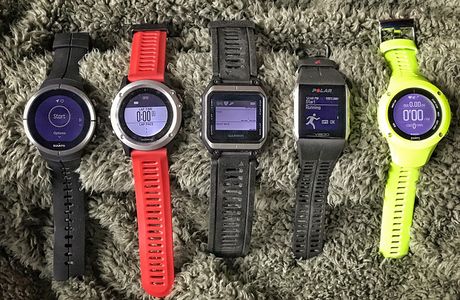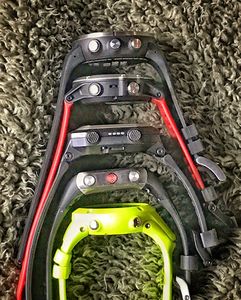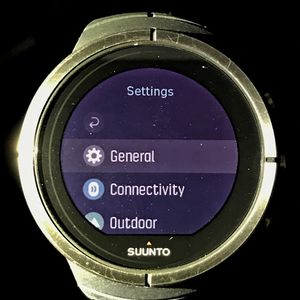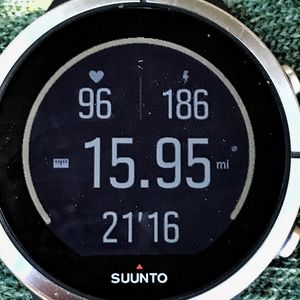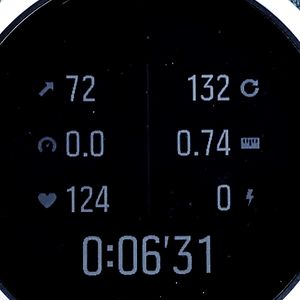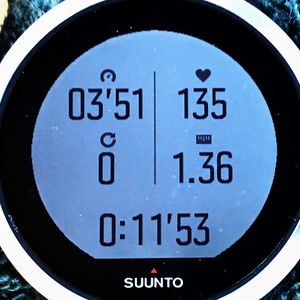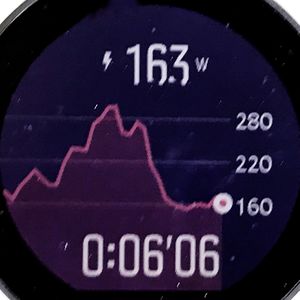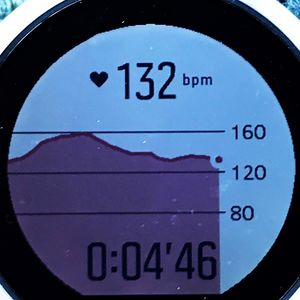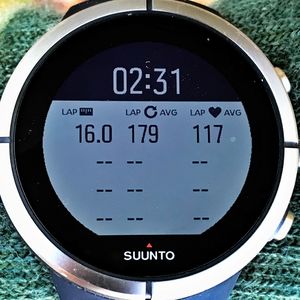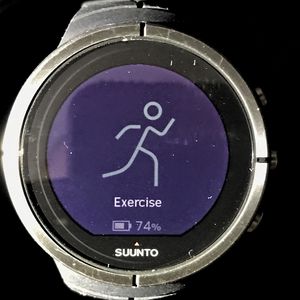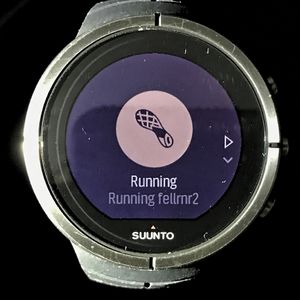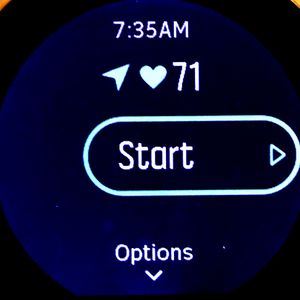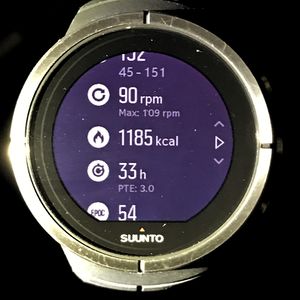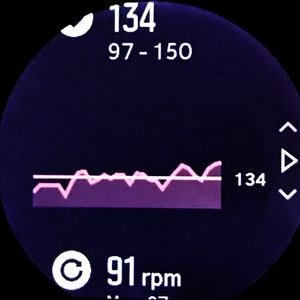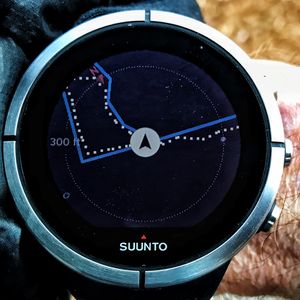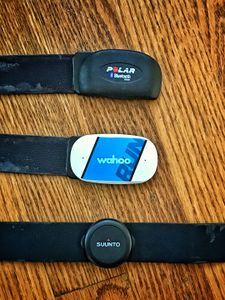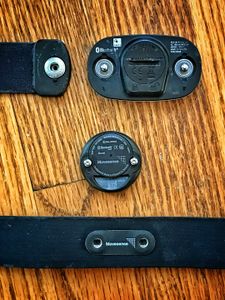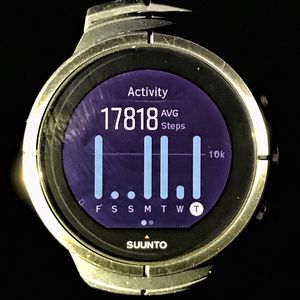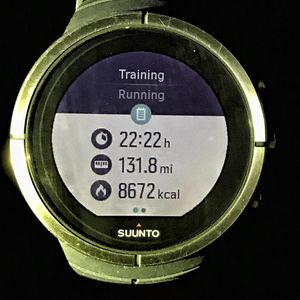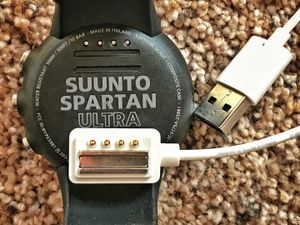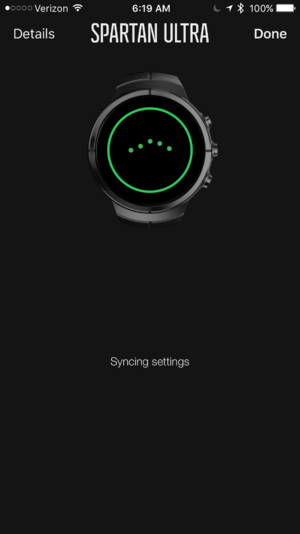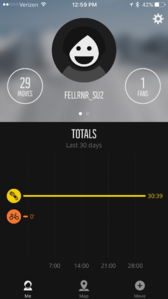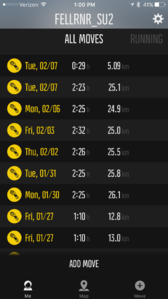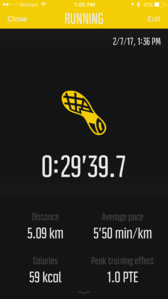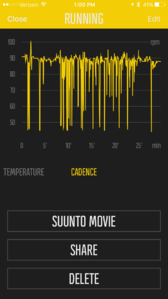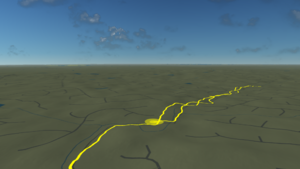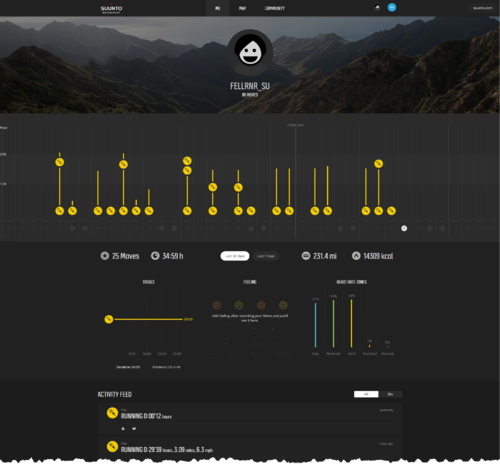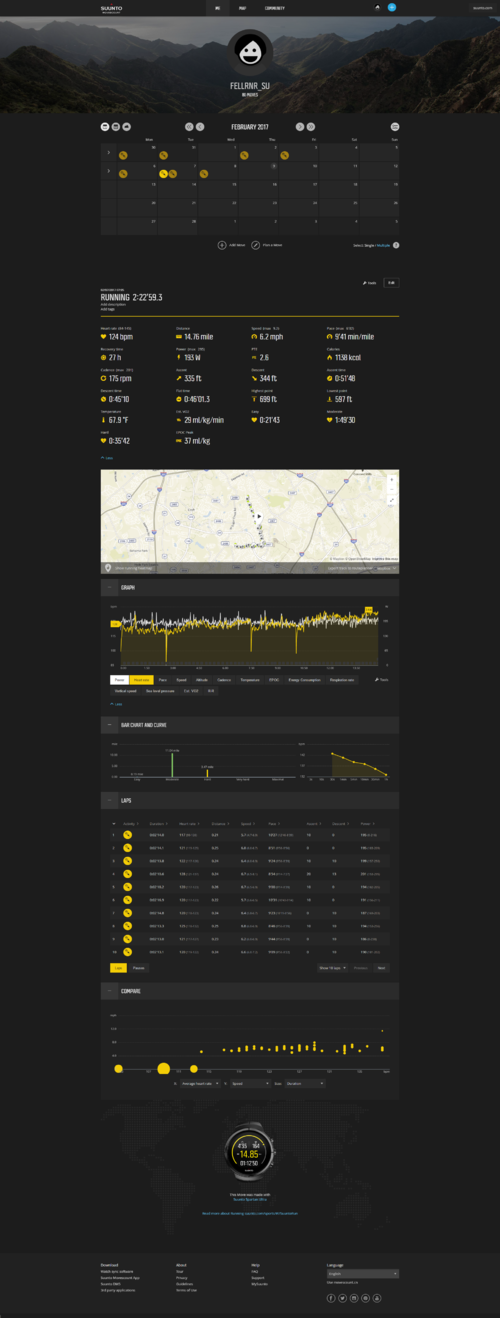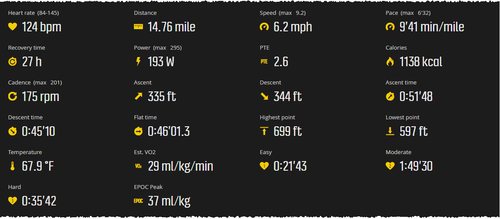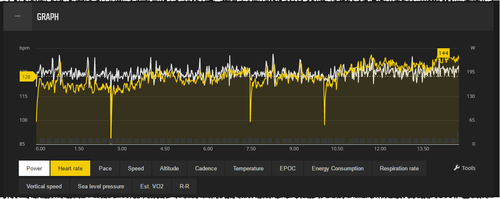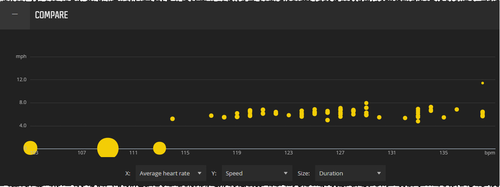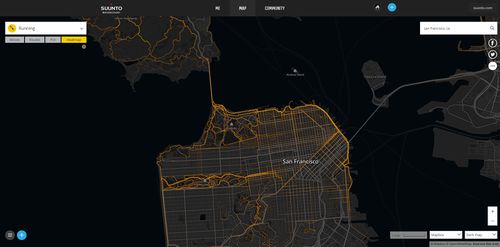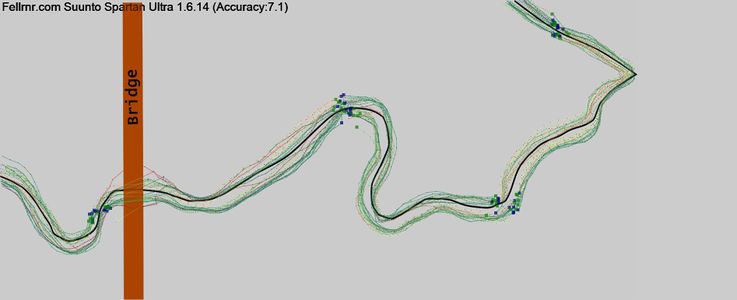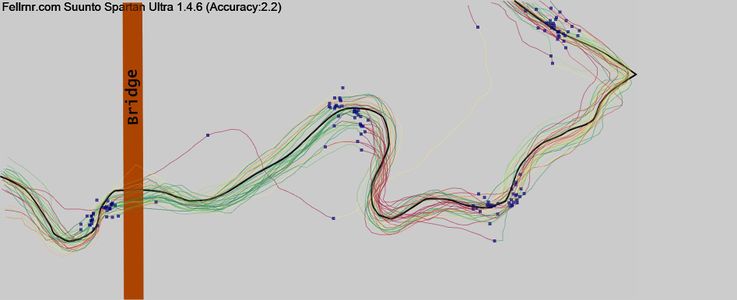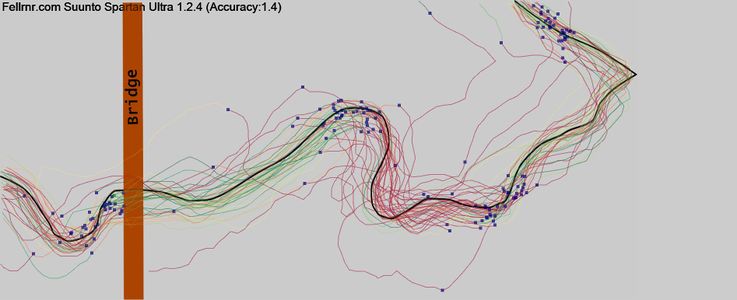Suunto Spartan Ultra Review
The Suunto Spartan is an expensive but beautiful running watch. It has an elegant, simplistic physical design, combined with an effective and intuitive user interface. The materials are not only beautiful to look at, but like the ambit range before, there pleasing to the touch. Unfortunately, this beautiful design is let down by incomplete functionality and a rather hefty price tag. If you buy the Spartan, it should be predominantly because of its looks and feel, rather than its functionality. (This review is based on 1.11.56 firmware.)
Contents
[hide]- 1 Support This Site
- 2 The Big Questions
- 3 Will It Be Nice When It's Finished?
- 4 Physical Characteristics
- 5 User Interface
- 6 Configuration
- 7 Going For A Run
- 8 Navigation
- 9 Sensors
- 10 Activity Tracking
- 11 Syncing The Spartan
- 12 Smartphone App
- 13 Moves Count Web Site
- 14 Battery Life
- 15 GPS Accuracy
- 16 Heart Rate Variability
- 17 Comparison Table
- 18 Navigation Features
1 Support This Site

| This review was made possible by readers like you buying products via my links. I buy all the products I review through normal retail channels, which allows me to create unbiased reviews free from the influence of reciprocity, or the need to keep vendors happy. It also ensures I don't get "reviewer specials" that are better than the retail versions.
|
2 The Big Questions
For a simple evaluation of a GPS watch, I look at how well it can answer some basic questions. There are many things a runner might look for in a running watch, but I feel these four questions are critical.
- How far did I run? This is the most basic question, and the Spartan has pretty good GPS Accuracy. The level of error will depend on your route, but the Spartan seems to do quite well on varied sections of my test. The Spartan has great support for the Stryd footpod which will provide the best accuracy.
- How fast am I running? Knowing how fast you're running can be a nice to know, or it can be vital for your training or race performance. Because of the nature of GPS, watches that rely on GPS signal alone tend to have serious problems with current pace. Currently the Spartan will display your current Pace From A Footpod while getting all other data from GPS, something I find is the best option. When paired a Stryd footpod, the pace data is vastly better than any GPS watch.
- Where am I? The Spartan has a breadcrumbs-display and the ability to download a course outline, but there's no "off course" warnings or directional information. There's also no "back to start" though you could manually add the start as a waypoint. The navigation to waypoints works reasonably well. It does have a true magnetic compass, though I've rarely found that useful in the real world.
- What's my cadence? Cadence is one of the most critical and often overlooked aspects of running. If you get your Cadence right, many other things naturally fall into place. The Spartan will get Cadence from a Footpod, and it has an internal accelerometer, though I find that's not as accurate. There are no alerts for Cadence (or any other metric.)
For ultramarathon running the battery life of the Spartan makes it a candidate for shorter races (50 miles/100k). But if you hope to be still moving during the Second Dawn, then you should look elsewhere. (You can charge the Spartan on the run, but I see that as a poor solution to the problem.) See Watches for Ultrarunning for more details.
3 Will It Be Nice When It's Finished?
The Spartan has improved in many areas since it was first released, but it still feels incomplete. The first firmware versions I tested seemed like they were barely ready for beta testing, let alone production release. These early versions of the firmware didn't have even the most basic functionality, such as the ability to customize the displays. It seems like Suunto still have quite some distance to go before the firmware is relatively complete, and this poses a significant risk to purchasers. If Suunto were to abandon updates, as happened to the Garmin Epix, you'd be left with a rather inadequate device. So, will the Spartan be a nice watch when they finally finish the updates? Predicting the future is something of a fool's errand, as nicely described in The Signal and the Noise, but so far there are no indications that the Spartan will have much to justify its price tag. It is an attractive watch, made from lovely materials, and it has the highest resolution display of any watch I've tested. But beyond that these anesthetics, I don't see any functional aspects that make the Spartan a compelling purchase. There are a number of things that I feel are missing on the Spartan.
- Something Novel. To belabor the point a little, to justify this price tag, I'd like some new feature rather than a nice display and materials. I've not found anything innovative that the Spartan provides, nor does there appear to be anything on their roadmap.
- Apps. Suunto were the first sports watch manufacturer to allow extensibility through apps. These apps were relatively simple and nothing like the complexity and sophistication of Garmin's Connect IQ, but they allowed for new functionality to be added by the community. Sadly, this functionality is not available in the Spartan, but I hope it eventually gets added in. It would be even better if they include some of the rich options that are available with Connect IQ. I've really come to appreciate the custom watch faces, new data fields, and support for niche Running Sensors.
- Display Customization. With the latest firmware, you can do some customization, but it's still limited. You can't customize to add a 7-field display or a graph.
- Navigation. There's only a primitive display of the course you load, not waypoints, off course notifications, distance to the end, backtrack, etc.
- Where's my phone? I've come to appreciate the Garmin "Where's My Phone?" feature that buzzes the phone to help you find it. It's one of the most useful bits of having a watch connected to the phone.
- Stability. This is becoming less of a problem, and I'm not seeing a problem with existing functionality becoming broken with the latest release.
4 Physical Characteristics
The Spartan is a big watch, though it is dwarfed by earlier devices like the Garmin 910XT which always felt like wrist mounted computers. On my minuscule wrists, the Spartan feels large, but not cumbersome or awkward. The design seems to epitomize the simplistic elegance that the Scandinavians and Finns are renowned for. There is nothing about the Spartan that indicates it's a sports watch, and I feel that it would not look out of place when worn with more formal clothing. It's a far less fussy design than the Garmin Fenix 3 and like other Suunto watches, the strap is made of wonderfully soft material that feels pleasant next to the skin. Below you can see the Spartan next to some of its competitors. To the right of the Spartan is the Garmin Fenix 3, which is probably closest in terms of style and tactile qualities. It's a little more rugged with its exposed bolt heads, but this also makes it a little more visually fussy. Next is the Garmin Epix that has a little more functionality than the Spartan, adding in preloaded maps which is great for navigation. As we continue to move right, the Polar V800 has similar design aesthetics to the Spartan, using high-quality materials and an elegant, simplistic layout. The Polar does not have the conventional design of the Spartan but it is a beautiful watch. The polar lacks a color display, but has outstanding GPS accuracy. Finally, we have the Suunto Ambit3, which is here to show an earlier (and much cheaper) offering from Suunto.
Looking at these watches side on, you can get a sense of their bulk. They are surprisingly similar, and none of them could be considered thin or svelte, but they are less bulky than some of the earlier devices.
One minor feature I appreciate is the "standby backlight" which is a dim level of backlight that is always on. This makes the Spartan much easier to read indoors and dim conditions without burning through the battery.
5 User Interface
The user interface has 3 buttons and a touchscreen, and is generally clean and intuitive. The menu system has a simple up/down/enter approach, with one of the menu options being a return to the previous level. You can use the touchscreen to navigate the menu as an alternative, but in most cases I found it easier to just use the buttons. I prefer a user interface with more buttons so that each has a specific function, but the Spartan handles things with just 3 buttons reasonably well. There are a few touch-only actions, such as a 2 finger tap to turn on and off the backlight, or pinch-to-zoom on the map. The interface is mostly responsive, though occasionally there is a slight lag. The display is much higher resolution than other watches I've tested to date, and the Spartan makes good use of this by putting more data on the screen. There are a few oddities, such as using the middle button to start a run, then the top button to pause/resume. In the scale of the infuriating user interfaces that some watches have (I'm looking at you Epson) the Spartan is a delight.
6 Configuration
Most of the configuration of the Spartan has to be done via their website and then synced to the watch. There is some configuration built-in, but not much. I generally prefer having a website for configuration as it's much easier than trying to do it on the watch, but it does mean you can't change the configuration when you're away from your computer. Most running watches have a few modes to choose from, such as running indoors or running outside, along with other sports such as cycling or swimming. The Spartan has dozens of modes with the idea that the watch would be configured more specifically. There are modes like "interval running", "race running", "track running", etc. This is an interesting approach as it allows the watch to be set up for that specific activity, displaying different information in different situations. You can also configure the sensors that are used and the GPS accuracy/battery life trade-off for each mode. Unfortunately, in their haste to release the Spartan they did not support the creation of new modes or the customization of the display. This has been partly remedied, but when you add a new custom mode, you have exactly 3 screens to configure; a 4-field display, a 5-field display, and a list of recent laps.
Based on the press releases, I believe there will be more customization in the future. Below is the 5 field display and the lap display. The display of recent laps is rather cool, as you can compare your split times, or heart rate across each lap. Or at least, it was in the last firmware; it the latest this functionality is broken.
7 Going For A Run
To start a run, you simply select the exercise mode, wait for the Spartan to acquire a satellite lock and a link to any sensors and then hit start. If you've synced your Spartan in the last few days, then it should acquire a satellite lock quite quickly. For my accuracy tests I always give a watch at least 5 minutes so that it can download the real satellite position information (ephemeris) rather than having it rely on the predictions it downloads during the sync. The current firmware will show when a heart rate monitor or other sensor (like Stryd is connected. The Spartan display is remarkably crisp, and they put more data on the screen than other watches which can sometimes make it a little tricky to read. Like most watch displays, you sometimes have to tweak the angle so the light hits it right for optimum clarity. When you finished your run, the Spartan will give a nice list of summary statistics, plus a screen of listing some averages for each lap (assuming you recorded some laps of course.) Suunto make use of heart rate analysis from Firstbeat. This means that included in the usual summary metrics are the recovery time in hours, the Peak Training Effect (PTE, a measure of workout intensity), and even an EPOC value (Excess Post-exercise Oxygen Consumption.) EPOC is an estimate of training impact, based around the elevated metabolic rate following exercise.
The Spartan will show a breadcrumbs trail of where you've run, which can be useful for backtracking. You can also load a course into the Spartan and follow it on your run. Creating a course on the Moves Count website is fairly straightforward and intuitive, and they include an elevation profile of the route. The Spartan makes good use of color on its map display, making it fairly easy to understand. It won't tell you when you are off course, or how far it is to the end, or anything else you might expect if you've used a Garmin. All you get is the course outline on the display. You can add waypoints and the Spartan will allow you to navigate to them, including a direction arrow and distance to the point. There's no preloaded maps, something that I'd like to see in a watch this expensive. If you want preloaded maps, then your best bet is the Garmin Fenix 5X (expensive), or either the Leikr or the Garmin Epix (not well supported by the manufacturer).
9 Sensors
The Spartan works with the various Bluetooth heart rate monitors I tried, including the Polar H7, Wahoo TICKR Run, and Suunto's own heart rate monitor. I found the heart rate monitor that is optionally packaged as with the Spartan worked fine, though I've generally used the Wahoo as I can get the heart rate data on any Ant+ watches I'm also using. The Spartan has an internal accelerometer that will give a reading for Cadence without a Footpod, and I'd say this is broadly adequate but far from perfect. I tested the Spartan with the Polar Stride Sensor and the Adidas footpod and they transmitted pace and cadence information.
9.1 Stryd
The Spartan is unusual in supporting the Stryd footpod natively, a Running Sensor that will transmit "Running Power." It's nice to see these new Running Sensors supported as first-class devices as it provides more insight into the power estimate than from a Garmin watch. The Spartan will display average power for the run, average power for the interval, average power for the lap, maximum power for the lap (great for High Intensity Interval Training), maximum power for the run, average power for 3 seconds, 10 seconds, and 30 seconds.
10 Activity Tracking
Like most modern running watches, the Spartan will act as an activity tracker by counting steps. This seems to be something of an afterthought with the Spartan as the standard display does not show your step of progress unless you press the middle button. The Spartan step counting seems to be reasonably in line with the other devices that I've tested. There's always some variation in the precise account, as different watches will detect or ignore small steps, especially if you doing something like cooking and moving around the kitchen rather than striding down the path on a walk. The target number of steps for the day is set on the Spartan, not the web site, which is a little confusing. The Spartan will track recovery time based on the Firstbeat algorithms, something I've found of extremely limited value. The sleep tracking seems worse than Garmin watches, though I don't have a gold standard to compare against to provide an objective evaluation.
11 Syncing The Spartan
You can either sync the Spartan using a USB cable to a computer, or over Bluetooth to the smart phone app. I found that syncing to the smart phone app has been a little patchy, and I generally rely on the PC app, though this has improved with newer releases.
Syncing the Spartan will upload your workouts to their website, download information to speed up satellite lock (SGEE or Server Generated Extended Ephemeris), and to download any configuration changes you've made on the website.
12 Smartphone App
The Suunto Moves Count smart phone app for the Spartan is rather limited, and like the watch itself feels incomplete. The most obvious functional deficiency is that you can't configure the Spartan from the app; you have to go to the website. When I compare this to the Garmin app, this feels like a prototype. If you have your Spartan connected to your smartphone, you will get notifications for things like incoming texts and anything else that you have a phone notification for. You can disable the notifications while keeping your Spartan and phone linked.
13 Moves Count Web Site
I know of runners that find the Garman site more intuitive and richer in functionality than the Suunto, but I'm the opposite. I find the Move Account website to be reasonably intuitive and rich in functionality. The Suunto website exposes some interesting information from the Spartan, and provides some good analysis options. Below is the overview page from the website. I rather like the top calendar view, that shows each workout along with a vertical line indicating the duration. This gives a nice summary of your recent training, and it should give you a sense of the ratio of training to rest. The middle section shows how much time you spent in each sport, which is much use if you just run. It also includes a cross of how you felt after each workout, something you said on the Spartan after each workout. It's possible that this may be a useful tool to prevent Overtraining, but I suspect it's a little too simplistic. On the right of the middle section is how long you've spent in each heart rate zone, which is another nice feature providing some high-level insight into training. At the bottom of the page is the list of workouts, which I've truncated to save space. Clicking on a workout take you to the detail page which will look at next.
Here's the workout detail page in its entirety. It's too small to read, so click to view a larger image or simply scroll down as we look at each section in turn.
the first section under the calendar (which will ignore as it's pretty obvious) are the summary statistics for your run. There's all the usual things you'd expect like heart rate, which includes average plus minimum and maximum, pace, calories, cadence etc., but there's also some interesting additions. Suunto license Firstbeat's heart rate analysis so you get things like Peak Training Effect which is a measure of how intense your workout was. There's also EPOC (Excess Post-exercise Oxygen Consumption) that's an estimate of how much your metabolic rate is elevated following exercise. The Estimated VO2 is also from Firstbeat, which could be estimated from your V̇O2max and Maximum Heart Rate, but few runners know their Maximum Heart Rate (which can't be calculated), let alone their V̇O2max.
The graph section allows you to overlay different metrics, and here you can see my heart rate compared with the estimate of Running Power provided by my Stryd sensor. The ability to overlay different metrics is a great tool for evaluating a workout. In addition to the usual metrics, and the Firstbeat estimated VO2 & EPOC mentioned above there is also respiration rate, a rather unusual metric to see. This is also a Firstbeat estimated metric calculated from Heart Rate Variability.
An even more sophisticated option for visual analysis is the compare section the plots a scatter graph of 3 metrics. Below you can see my average heart rate against my speed, with the duration at that point given by the size. (This particular run is skewed by the time I spent changing shoes, so you see a large duration where I'm not moving.) This section of the website will probably only appeal to the geeks, but it's a really nice feature to see.
Probably the coolest feature of the Moves Count website is one that makes it worth using for any runner, regardless of the type of watch they use. The heat map display shown below highlights where runners have recorded their work, giving a wonderful overview of the most popular running locations in any given area. The limitation of course is that it only represents data uploaded from Suunto devices, and there's not much data for less populated areas. Nonetheless, this is a great resource when you're looking for a new running route, or visiting a strange city.
14 Battery Life
Suunto claim 18 hours of battery life, but I only got 17 hours in my testing. That's enough for most runners, but if you're into Ultramarathons, I'd suggest looking elsewhere. The Spartan can extend its battery life by reducing GPS accuracy, but even then, it's only 26 hours.
15 GPS Accuracy
When the Spartan was released it had the worst GPS Accuracy of any watch I've tested. Subsequent firmware upgrades gradually improved the situation, and as of release 1.6.14 the accuracy is pretty good. (The actual GPS firmware is 5.7.10-P2.1-SNT.003.) My GPS Accuracy page has detailed, objective, statistical analysis of the Spartan and many other watches. I know that many readers prefer something a little less technical, so I've also included some rather more subjective visual representations below. You can see the improvement in the tracks with the updated firmware, as they are now closer together and have far fewer that wandered off on their own. You'll notice that the tracks form 2 distinct paths along the middle portion of the image, and it's not clear to me why this might be. My actual running path goes over the same points in both direction, and the split between the 2 sets of tracks does not appear to be directional. If you look at the lap markers you'll see that they are reasonably close together, which suggests both reasonable positional accuracy and fairly good responsiveness of the watch to the pressing of the lap button. The Spartan seems to have a few problems going under the bridge, which is not surprising, but seems to recover reasonably quickly. If you look at the color coding of the tracks, you'll see the middle, curved section has relatively good accuracy. I find this rather surprising, as this is a section that causes most watches the greatest issues. By comparison, the rightmost section with the sharp right angle turn does rather worse, and this is a section that most watches do okay on. If you look at the statistical analysis, you'll notice that the Spartan has relatively good trueness but poor precision compared with watches that have similar overall accuracy ratings. This means that compared with the watches of a similar accuracy rating, over a quarter of a mile distance (400 m) the Spartan is less likely to be correct, but over greater distances these errors are more likely to even out. These results are with GLONASS turned off, and I've seen dramatically worse results with it enabled.
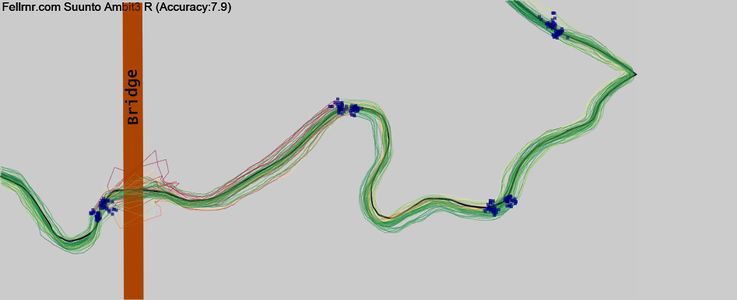 Here's how the Suunto Ambit3's accuracy looks. |
15.1 SGEE and Accuracy
There are some suggestions online that syncing the Spartan before you run will improve GPS accuracy. The idea is that the sync will update the cache of satellite information (SGEE), which in turn will improve accuracy. This satellite information is a prediction of the GPS Ephemeris data, which gives information needed to use a satellite's signal for calculating the watch's position. Because it takes about 30 seconds to get a satellite's Ephemeris, having it preloaded reduces the time to get a usable location (Time To First Fix, TTFF.) This predicted Ephemeris data is not typically used to improve accuracy, but a publication from Telit suggests otherwise for the chipset used in the Spartan. The document is rather ambiguous, but I interpret it to mean that for the time between the watch getting an initial fix using the SGEE data and getting the true Ephemeris from the satellite the accuracy will be compromised. Given this should only be for a minute or so at the start of a run, this shouldn't have a practical impact. It's possible the situation may reoccur mid-run as satellites drop below the horizon and others rise up, as the watch will use SGEE data until the new satellites Ephemeris has been downloaded. To test how this worked in practice I did a few runs with the SGEE data expired (>7 days since the last sync) and I found that the GPS accuracy was not impaired. If anything, the accuracy might have been better without SGEE data, but I didn't collect enough data for statistical analysis. Of course, it's possible that slightly stale, but usable SGEE data might cause a problem. To test that I'd need to wait for a few days between syncing and gathering data, and repeat that for every run, which would take ages.
16 Heart Rate Variability
The Spartan will record Heart Rate Variability (HRV) and export it in either FIT or XLS format. This can be processed in Runalzye or other similar software. There's no real-time display of HRV, but that functionality is pretty rare.
17 Comparison Table
I evaluate running watches in three distinct ways. Firstly, you can use a watch on its own, without any kind of Footpod. This is probably the most common way runners use their watch, but you miss out on a lot. The second rating is with a standard Footpod that is available quite cheaply. These Footpod's can be reasonably accurate once the calibrated, but calibration is a little tedious. The final evaluation is with the Stryd Footpod, which is vastly more accurate than any other type of Footpod, or and more accurate than GPS. The table below looks at the score, and the value for money of each watch for each of the three conditions. (I’ve also tested the Apple Watch 3, but I’ve not included it in these tables as it’s not really a running watch.)
| Review ▼ | With Stryd Score | With Stryd Value for money | With Footpod Score | With Footpod Value for money | Without Footpod Score | Without Footpod Value for money | Price at Amazon.com |
|---|---|---|---|---|---|---|---|
| Garmin Epix Review | 47 | 4.5 | 31 | 3.9 | 23 | 3.4 | Error: Could not parse data from Amazon! |
| Garmin Fenix 5X Review | 47 | 2.9 | 32 | 2.3 | 24 | 1.9 | Error: Could not parse data from Amazon! |
| Garmin Fenix 3 Review | 45 | 3.8 | 28 | 3.1 | 24 | 3 | Error: Could not parse data from Amazon! |
| Garmin 935 Review | 45 | 3.6 | 30 | 3 | 22 | 2.4 | Error: Could not parse data from Amazon! |
| Garmin Vivoactive HR Review | 40 | 4.9 | 21 | 3.8 | 17 | 3.8 | Error: Could not parse data from Amazon! |
| Garmin 920XT Review | 39 | 4.4 | 30 | 4.7 | 24 | 4.5 | Error: Could not parse data from Amazon! |
| Suunto Spartan Ultra Review | 37 | 2.6 | 27 | 2.3 | 23 | 2.1 | Error: Could not parse data from Amazon! |
| Garmin Vivoactive 3 Review | 36 | 4 | 19 | 2.9 | 15 | 2.8 | Error: Could not parse data from Amazon! |
| Garmin Vivoactive Review | 34 | 5.1 | 14 | 3.4 | 10 | 3.3 | Error: Could not parse data from Amazon! |
| Suunto Spartan Trainer Review | 34 | 3.9 | 23 | 3.7 | 18 | 3.4 | Error: Could not parse data from Amazon! |
| Polar V800 Review | 33 | 2.8 | 26 | 2.8 | 22 | 2.7 | Error: Could not parse data from Amazon! |
| Suunto Ambit2 Review | 32 | 3.9 | 25 | 4.3 | 21 | 4.5 | Error: Could not parse data from Amazon! |
| Suunto Ambit3 Peak Review | 32 | 3.4 | 29 | 4.1 | 25 | 4.2 | Error: Could not parse data from Amazon! |
| Garmin Fenix 2 Review | 31 | 2.9 | 22 | 2.7 | 18 | 2.5 | Error: Could not parse data from Amazon! |
| Suunto Ambit3 Run Review | 30 | 4 | 27 | 5.5 | 23 | 5.9 | Error: Could not parse data from Amazon! |
| Suunto Ambit2 R Review | 30 | 3.5 | 23 | 3.8 | 19 | 3.8 | Error: Could not parse data from Amazon! |
| Garmin 235 Review | 28 | 2.9 | 20 | 2.8 | 12 | 2 | Error: Could not parse data from Amazon! |
| Garmin 620 Review | 27 | 3.8 | 24 | 5.1 | 20 | 5.6 | Error: Could not parse data from Amazon! |
| Garmin 910XT Review | 26 | 3.9 | 26 | 6.1 | 21 | 6.7 | Error: Could not parse data from Amazon! |
| Garmin 310XT Review | 25 | 4.6 | 24 | 8.3 | 18 | 10 | Error: Could not parse data from Amazon! |
| Polar M400 Review | 25 | 4.3 | 15 | 4.5 | 11 | 4.9 | Error: Could not parse data from Amazon! |
| Garmin 225 Review | 25 | 3.8 | 13 | 3.1 | 9 | 2.9 | Error: Could not parse data from Amazon! |
| TomTom Cardio Runner Review | 25 | 3.3 | 10 | 2 | 10 | 2.5 | Error: Could not parse data from Amazon! |
| Polar M430 Review | 25 | 3.2 | 15 | 2.9 | 11 | 2.7 | Error: Could not parse data from Amazon! |
| Garmin 610 Review | 24 | 3.3 | 20 | 4.3 | 14 | 3.9 | Error: Could not parse data from Amazon! |
| Leikr Review | 10 | 1 | 20 | 2.5 | 14 | 2 | Leikr ($380) |
| Epson SF-510 Review | 4 | 0.7 | 6 | 2 | 6 | 3 | Error: Could not parse data from Amazon! |
| Epson SF-810 Review | 4 | 0.6 | 6 | 1.6 | 6 | 2.3 | Error: Could not parse data from Amazon! |
| Garmin 10 Review | 2 | 0.3 | 2 | 0.6 | 2 | 0.9 | Error: Could not parse data from Amazon! |
The score is the sum of how well each watch can answer the four basic questions (how far, how fast, where are you, what's your cadence), plus some bonus points.
- The "How far you've run" will be based on GPS only for "without Footpod" and "with Standard Footpod", but based on Stryd if supported in the "with Stryd Footpod" table..
- How fast you're running assumes you're using a Footpod if it's supported, otherwise the rating is 0-2 based on GPS accuracy.
- The "Where are you?" is based on various navigation features such as back to start, breadcrumbs, and preloaded maps. For some watches, you have to turn GPS off to get the benefit of Stryd, so those watches have worse "where are you scores" with Stryd than without.
- The cadence score uses 1 point for an internal cadence sensor, 2 points for footpod support, 1 point for support from chest strap cadence, and 1 point for cadence alerts.
- I give 1-2 bonus points for application support, 1-2 bonus points for data upload, 1-2 bonus points for Optical Heart Rate Monitoring, and 0-1 bonus points for battery life.
- Value for money is the score divided by the price (at the time I last updated the table.) Your needs may be different, so you might weight the different aspects of the watches differently, or be basing your decision on different criteria totally. Hopefully this table will give you a good starting point for your decision.
17.1 Score Breakdown without a Footpod
| Review ▼ | Score | Value for money6 | How far did you run?1 |
How fast are you running?2 |
Where are you?3 |
What's your cadence?4 |
Bonus Points5 | class="unsortable" |
Price at Amazon.com |
|---|---|---|---|---|---|---|---|---|
| Suunto Ambit3 Peak Review | 25 | 4.2 | 8 | 3 | 6 | 2 | 6 | Error: Could not parse data from Amazon! |
| Garmin 920XT Review | 24 | 4.5 | 1 | 2 | 7 | 6 | 8 | Error: Could not parse data from Amazon! |
| Garmin Fenix 3 Review | 24 | 3 | 2 | 1 | 7 | 6 | 8 | Error: Could not parse data from Amazon! |
| Garmin Fenix 5X Review | 24 | 1.9 | 1 | 0 | 9 | 6 | 8 | Error: Could not parse data from Amazon! |
| Suunto Ambit3 Run Review | 23 | 5.9 | 8 | 3 | 5 | 2 | 5 | Error: Could not parse data from Amazon! |
| Garmin Epix Review | 23 | 3.4 | 0 | 0 | 9 | 6 | 8 | Error: Could not parse data from Amazon! |
| Suunto Spartan Ultra Review | 23 | 2.1 | 8 | 2 | 6 | 2 | 5 | Error: Could not parse data from Amazon! |
| Polar V800 Review | 22 | 2.7 | 9 | 4 | 3 | 2 | 4 | Error: Could not parse data from Amazon! |
| Garmin 935 Review | 22 | 2.4 | 1 | 0 | 7 | 6 | 8 | Error: Could not parse data from Amazon! |
| Garmin 910XT Review | 21 | 6.7 | 5 | 3 | 6 | 2 | 5 | Error: Could not parse data from Amazon! |
| Suunto Ambit2 Review | 21 | 4.5 | 4 | 3 | 6 | 2 | 6 | Error: Could not parse data from Amazon! |
| Garmin 620 Review | 20 | 5.6 | 3 | 2 | 2 | 6 | 7 | Error: Could not parse data from Amazon! |
| Suunto Ambit2 R Review | 19 | 3.8 | 4 | 3 | 5 | 2 | 5 | Error: Could not parse data from Amazon! |
| Garmin 310XT Review | 18 | 10 | 7 | 2 | 4 | 0 | 5 | Error: Could not parse data from Amazon! |
| Suunto Spartan Trainer Review | 18 | 3.4 | 5 | 3 | 4 | 2 | 4 | Error: Could not parse data from Amazon! |
| Garmin Fenix 2 Review | 18 | 2.5 | 1 | 0 | 6 | 6 | 5 | Error: Could not parse data from Amazon! |
| Garmin Vivoactive HR Review | 17 | 3.8 | 0 | 0 | 2 | 6 | 9 | Error: Could not parse data from Amazon! |
| Garmin Vivoactive 3 Review | 15 | 2.8 | 0 | 0 | 4 | 4 | 7 | Error: Could not parse data from Amazon! |
| Garmin 610 Review | 14 | 3.9 | 3 | 2 | 3 | 2 | 4 | Error: Could not parse data from Amazon! |
| Leikr Review | 14 | 2 | 5 | 2 | 4 | 0 | 3 | Leikr ($380) |
| Garmin 235 Review | 12 | 2 | 0 | 0 | 2 | 2 | 8 | Error: Could not parse data from Amazon! |
| Polar M400 Review | 11 | 4.9 | 3 | 1 | 1 | 2 | 4 | Error: Could not parse data from Amazon! |
| Polar M430 Review | 11 | 2.7 | 3 | 1 | 1 | 2 | 4 | Error: Could not parse data from Amazon! |
| Garmin Vivoactive Review | 10 | 3.3 | 0 | 0 | 0 | 6 | 4 | Error: Could not parse data from Amazon! |
| TomTom Cardio Runner Review | 10 | 2.5 | 2 | 1 | 0 | 2 | 5 | Error: Could not parse data from Amazon! |
| Garmin 225 Review | 9 | 2.9 | 1 | 1 | 0 | 2 | 5 | Error: Could not parse data from Amazon! |
| Epson SF-510 Review | 6 | 3 | 0 | 0 | 0 | 2 | 4 | Error: Could not parse data from Amazon! |
| Epson SF-810 Review | 6 | 2.3 | 1 | 0 | 0 | 2 | 3 | Error: Could not parse data from Amazon! |
| Garmin 10 Review | 2 | 0.9 | 0 | 0 | 0 | 0 | 2 | Error: Could not parse data from Amazon! |
17.2 Score Breakdown with a Standard Footpod
| Review ▼ | Score | Value for money6 | How far did you run?1 |
How fast are you running?2 |
Where are you?3 |
What's your cadence?4 |
Bonus Points5 | class="unsortable" |
Price at Amazon.com |
|---|---|---|---|---|---|---|---|---|
| Garmin Fenix 5X Review | 32 | 2.3 | 1 | 4 | 9 | 10 | 8 | Error: Could not parse data from Amazon! |
| Garmin Epix Review | 31 | 3.9 | 0 | 4 | 9 | 10 | 8 | Error: Could not parse data from Amazon! |
| Garmin 920XT Review | 30 | 4.7 | 1 | 4 | 7 | 10 | 8 | Error: Could not parse data from Amazon! |
| Garmin 935 Review | 30 | 3 | 1 | 4 | 7 | 10 | 8 | Error: Could not parse data from Amazon! |
| Suunto Ambit3 Peak Review | 29 | 4.1 | 8 | 3 | 6 | 6 | 6 | Error: Could not parse data from Amazon! |
| Garmin Fenix 3 Review | 28 | 3.1 | 2 | 1 | 7 | 10 | 8 | Error: Could not parse data from Amazon! |
| Suunto Ambit3 Run Review | 27 | 5.5 | 8 | 3 | 5 | 6 | 5 | Error: Could not parse data from Amazon! |
| Suunto Spartan Ultra Review | 27 | 2.3 | 8 | 2 | 6 | 6 | 5 | Error: Could not parse data from Amazon! |
| Garmin 910XT Review | 26 | 6.1 | 5 | 4 | 6 | 6 | 5 | Error: Could not parse data from Amazon! |
| Polar V800 Review | 26 | 2.8 | 9 | 4 | 3 | 6 | 4 | Error: Could not parse data from Amazon! |
| Suunto Ambit2 Review | 25 | 4.3 | 4 | 3 | 6 | 6 | 6 | Error: Could not parse data from Amazon! |
| Garmin 310XT Review | 24 | 8.3 | 7 | 4 | 4 | 4 | 5 | Error: Could not parse data from Amazon! |
| Garmin 620 Review | 24 | 5.1 | 3 | 2 | 2 | 10 | 7 | Error: Could not parse data from Amazon! |
| Suunto Ambit2 R Review | 23 | 3.8 | 4 | 3 | 5 | 6 | 5 | Error: Could not parse data from Amazon! |
| Suunto Spartan Trainer Review | 23 | 3.7 | 5 | 4 | 4 | 6 | 4 | Error: Could not parse data from Amazon! |
| Garmin Fenix 2 Review | 22 | 2.7 | 1 | 0 | 6 | 10 | 5 | Error: Could not parse data from Amazon! |
| Garmin Vivoactive HR Review | 21 | 3.8 | 0 | 0 | 2 | 10 | 9 | Error: Could not parse data from Amazon! |
| Garmin 610 Review | 20 | 4.3 | 3 | 4 | 3 | 6 | 4 | Error: Could not parse data from Amazon! |
| Garmin 235 Review | 20 | 2.8 | 0 | 4 | 2 | 6 | 8 | Error: Could not parse data from Amazon! |
| Leikr Review | 20 | 2.5 | 5 | 4 | 4 | 4 | 3 | Leikr ($380) |
| Garmin Vivoactive 3 Review | 19 | 2.9 | 0 | 0 | 4 | 8 | 7 | Error: Could not parse data from Amazon! |
| Polar M400 Review | 15 | 4.5 | 3 | 1 | 1 | 6 | 4 | Error: Could not parse data from Amazon! |
| Polar M430 Review | 15 | 2.9 | 3 | 1 | 1 | 6 | 4 | Error: Could not parse data from Amazon! |
| Garmin Vivoactive Review | 14 | 3.4 | 0 | 0 | 0 | 10 | 4 | Error: Could not parse data from Amazon! |
| Garmin 225 Review | 13 | 3.1 | 1 | 1 | 0 | 6 | 5 | Error: Could not parse data from Amazon! |
| TomTom Cardio Runner Review | 10 | 2 | 2 | 1 | 0 | 2 | 5 | Error: Could not parse data from Amazon! |
| Epson SF-510 Review | 6 | 2 | 0 | 0 | 0 | 2 | 4 | Error: Could not parse data from Amazon! |
| Epson SF-810 Review | 6 | 1.6 | 1 | 0 | 0 | 2 | 3 | Error: Could not parse data from Amazon! |
| Garmin 10 Review | 2 | 0.6 | 0 | 0 | 0 | 0 | 2 | Error: Could not parse data from Amazon! |
17.3 Score Breakdown with a Stryd Footpod
| Review ▼ | Score | Value for money6 | How far did you run?1 |
How fast are you running?2 |
Where are you?3 |
What's your cadence?4 |
Bonus Points5 | class="unsortable" |
Price at Amazon.com |
|---|---|---|---|---|---|---|---|---|
| Garmin Epix Review | 47 | 4.5 | 10 | 10 | 9 | 10 | 8 | Error: Could not parse data from Amazon! |
| Garmin Fenix 5X Review | 47 | 2.9 | 10 | 10 | 9 | 10 | 8 | Error: Could not parse data from Amazon! |
| Garmin Fenix 3 Review | 45 | 3.8 | 10 | 10 | 7 | 10 | 8 | Error: Could not parse data from Amazon! |
| Garmin 935 Review | 45 | 3.6 | 10 | 10 | 7 | 10 | 8 | Error: Could not parse data from Amazon! |
| Garmin Vivoactive HR Review | 40 | 4.9 | 10 | 10 | 1 | 10 | 9 | Error: Could not parse data from Amazon! |
| Garmin 920XT Review | 39 | 4.4 | 10 | 10 | 1 | 10 | 8 | Error: Could not parse data from Amazon! |
| Suunto Spartan Ultra Review | 37 | 2.6 | 10 | 10 | 6 | 6 | 5 | Error: Could not parse data from Amazon! |
| Garmin Vivoactive 3 Review | 36 | 4 | 10 | 10 | 1 | 8 | 7 | Error: Could not parse data from Amazon! |
| Garmin Vivoactive Review | 34 | 5.1 | 10 | 10 | 0 | 10 | 4 | Error: Could not parse data from Amazon! |
| Suunto Spartan Trainer Review | 34 | 3.9 | 10 | 10 | 4 | 6 | 4 | Error: Could not parse data from Amazon! |
| Polar V800 Review | 33 | 2.8 | 10 | 10 | 3 | 6 | 4 | Error: Could not parse data from Amazon! |
| Suunto Ambit2 Review | 32 | 3.9 | 10 | 10 | 6 | 0 | 6 | Error: Could not parse data from Amazon! |
| Suunto Ambit3 Peak Review | 32 | 3.4 | 10 | 10 | 6 | 0 | 6 | Error: Could not parse data from Amazon! |
| Garmin Fenix 2 Review | 31 | 2.9 | 10 | 10 | 6 | 0 | 5 | Error: Could not parse data from Amazon! |
| Suunto Ambit3 Run Review | 30 | 4 | 10 | 10 | 5 | 0 | 5 | Error: Could not parse data from Amazon! |
| Suunto Ambit2 R Review | 30 | 3.5 | 10 | 10 | 5 | 0 | 5 | Error: Could not parse data from Amazon! |
| Garmin 235 Review | 28 | 2.9 | 10 | 10 | 0 | 0 | 8 | Error: Could not parse data from Amazon! |
| Garmin 620 Review | 27 | 3.8 | 10 | 10 | 0 | 0 | 7 | Error: Could not parse data from Amazon! |
| Garmin 910XT Review | 26 | 3.9 | 10 | 10 | 1 | 0 | 5 | Error: Could not parse data from Amazon! |
| Garmin 310XT Review | 25 | 4.6 | 10 | 10 | 0 | 0 | 5 | Error: Could not parse data from Amazon! |
| Polar M400 Review | 25 | 4.3 | 10 | 10 | 1 | 0 | 4 | Error: Could not parse data from Amazon! |
| Garmin 225 Review | 25 | 3.8 | 10 | 10 | 0 | 0 | 5 | Error: Could not parse data from Amazon! |
| TomTom Cardio Runner Review | 25 | 3.3 | 10 | 10 | 0 | 0 | 5 | Error: Could not parse data from Amazon! |
| Polar M430 Review | 25 | 3.2 | 10 | 10 | 1 | 0 | 4 | Error: Could not parse data from Amazon! |
| Garmin 610 Review | 24 | 3.3 | 10 | 10 | 0 | 0 | 4 | Error: Could not parse data from Amazon! |
| Leikr Review | 10 | 1 | 5 | 2 | 0 | 0 | 3 | Leikr ($380) |
| Epson SF-510 Review | 4 | 0.7 | 0 | 0 | 0 | 0 | 4 | Error: Could not parse data from Amazon! |
| Epson SF-810 Review | 4 | 0.6 | 1 | 0 | 0 | 0 | 3 | Error: Could not parse data from Amazon! |
| Garmin 10 Review | 2 | 0.3 | 0 | 0 | 0 | 0 | 2 | Error: Could not parse data from Amazon! |
17.4 Basic Features
|
Review ▼ |
Released | GPS Accuracy |
Weight (oz) | Size (CM3) | Display (mm) | Resolution (Pixels) | Waterproofing ▼ | Heart Rate Monitor ▼ |
Cadence ▼ | Data Upload ▼ |
|---|---|---|---|---|---|---|---|---|---|---|
| Garmin Epix Review | 2015 | 6.2 | 3.0 | 48 | 29 x 21 (609mm2) | 205 x 148 (30.3K total) | Good (50m) | Yes | Internal/Footpod/Heart Rate Monitor/Alert | Yes |
| Garmin Fenix 5X Review | 2017 | 5.6 | 3.5 | 36 | 30.5 (round) (731mm2) | 240 diameter (45.2K total) | Good (100m) | Yes | Internal/Footpod/Heart Rate Monitor/Alert | Yes |
| Garmin Fenix 3 Review | 2015 | 6.2 | 2.9 | 33 | 30 (round) (726mm2) | 218 diameter (37.3K total) | Good (100m) | Yes | Internal/Footpod/Heart Rate Monitor/Alert | Yes |
| Garmin 935 Review | 2017 | 5.6 | 1.7 | 24 | 30.5 (round) (731mm2) | 240 diameter (45.2K total) | Good (100m) | Yes | Internal/Footpod/Heart Rate Monitor/Alert | Yes |
| Garmin Vivoactive HR Review | 2016 | 4.9 | 1.7 | 19 | 21 x 29 (609mm2) | 148 x 205 (30.3K total) | Good (50m) | Yes (+OHRM) | Internal/Footpod/Heart Rate Monitor/Alert | Yes |
| Garmin 920XT Review | 2014 | 6.6 | 2.2 | 35 | 29 x 21 (609mm2) | 205 x 148 (30.3K total) | Good (50m) | Yes | Internal/Footpod/Heart Rate Monitor/Alert | Yes |
| Garmin Vivoactive 3 Review | 2017 | 1.5 | 17 | 30.5 (round) (731mm2) | 240 diameter (45.2K total) | Good (50m) | Yes (+OHRM) | Internal/Footpod | Yes | |
| Garmin Vivoactive Review | 2015 | 5.4 | 1.3 | 13 | 29 x 21 (592mm2) | 205 x 148 (30.3K total) | Good (50m) | Yes | Internal/Footpod/Heart Rate Monitor/Alert | Yes |
| Suunto Spartan Trainer Review | 2017 | 7.8 | 2.0 | 25 | 24 x 23 (529mm2) | 128 diameter (12.9K total) | Good (50m) | Yes (+OHRM) | Internal/Footpod | Yes |
| Suunto Ambit2 Review | 2013 | 7.6 | 3.1 | 30 | 29 (round) (661mm2) | 128 diameter (12.9K total) | Good (100m) | Yes | Internal/Footpod | Yes |
| Suunto Ambit3 Peak Review | 2014 | 7.9 | 2.9 | 30 | 29 (round) (661mm2) | 128 diameter (12.9K total) | Good (100m) | Yes | Internal/Footpod | Yes |
| Suunto Spartan Ultra Review | 2016 | 7.1 | 2.7 | 38 | 32 (round) (804mm2) | 320 diameter (80.4K total) | Good (100m) | Yes | Internal (Limited Footpod) | Yes |
| Garmin Fenix 2 Review | 2014 | 5.7 | 3.2 | 32 | 31 (round) (755mm2) | 70 diameter (3.8K total) | Good (50m) | Yes | Internal/Footpod/Heart Rate Monitor/Alert | Yes |
| Suunto Ambit3 Run Review | 2014 | 7.9 | 2.5 | 30 | 29 (round) (661mm2) | 128 x 128 (16.4K total) | Good (50m) | Yes | Internal/Footpod | Yes |
| Suunto Ambit2 R Review | 2013 | 7.6 | 2.5 | 30 | 29 (round) (661mm2) | 128 diameter (12.9K total) | Good (50m) | Yes | Internal/Footpod | Yes |
| Garmin 235 Review | 2015 | 4.9 | 1.5 | 19 | 31 (round) (755mm2) | 215 diameter (36.3K total) | Good (50m) | Yes (+OHRM) | Internal/Footpod | Yes |
| Garmin 620 Review | 2013 | 7.1 | 1.5 | 20 | 25.4 (round) (507mm2) | 180 diameter (25.4K total) | Good (50m) | Yes | Internal/Footpod/Heart Rate Monitor/Alert | Yes |
| Garmin 910XT Review | 2011 | 7.5 | 2.5 | 49 | 33 x 20 (660mm2) | 160 x 100 (16K total) | Good (50m) | Yes | Footpod/Alert | Yes |
| Garmin 310XT Review | 2009 | 7.5 | 2.5 | 63 | 33 x 20 (660mm2) | 160 x 100 (16K total) | Good (50m) | Yes | Footpod | Yes |
| Garmin 225 Review | 2015 | 6.2 | 1.5 | 24 | 25.4 (round) (507mm2) | 180 diameter (25.4K total) | Good (50m) | Yes (+OHRM) | Internal/Footpod | Yes |
| TomTom Cardio Runner Review | 2015 | 6.0 | 2.2 | 30 | 22 x 25 (550mm2) | 144 x 168 (24.2K total) | Good (50m) | Yes (+OHRM) | Internal/Footpod | Yes |
| Polar V800 Review | 2014 | 8.0 | 2.8 | 31 | 23 x 23 (529mm2) | 128 x 128 (16.4K total) | Good (30m) | Yes | Internal/Footpod | Yes |
| Polar M430 Review | 2017 | 7.2 | 2.0 | 24 | 23 x 23 (529mm2) | 128 x 128 (16.4K total) | Good (50m) | Yes (+OHRM) | Internal/Footpod | Yes |
| Polar M400 Review | 2014 | 6.6 | 2.0 | 24 | 23 x 23 (529mm2) | 128 x 128 (16.4K total) | Good (30m) | Yes | Internal/Footpod | Yes |
| Garmin 610 Review | 2011 | 7.3 | 2.5 | 41 | 25.4 (round) (507mm2) | 128 diameter (12.9K total) | Fair (IPX7) | Yes | Footpod/Alert | Yes |
| Leikr Review | 2013 | 7.3 | 2.4 | 25 | 41 x 31 (1271mm2) | 206 x 148 (76.8K total) | Fair (IPX6) | Yes | Footpod | Limited |
| Epson SF-510 Review | 2015 | 4.4 | 1.7 | 24 | 28 x 22 (616mm2) | 128 x 96 (12.3K total) | Good (50m) | Yes | Limited Internal | Limited |
| Epson SF-810 Review | 2015 | 5.5 | 1.8 | 28 | 28 (round) (616mm2) | 128 diameter (12.9K total) | Good (50m) | OHRM Only) | Limited Internal | Limited |
| Garmin 10 Review | 2012 | 3.8 | 1.3 | 33 | 25 x 24 (600mm2) | 55 x 32 (1.8K total) | Good (50m) | No | No | Yes |
|
Review ▼ |
Battery Life (hr) |
Tested Battery Life (hr) |
Extended Battery Life (hr) |
Charge On The Run? ▼ | Training Effect |
HRV | GPS cache | Sensors |
|---|---|---|---|---|---|---|---|---|
| Garmin Epix Review | 24 | 17.6 | 50 | Yes (with USB=Garmin) | Yes | Record | Yes | Ant+ |
| Garmin Fenix 5X Review | 20 | 23 | 35 | Yes, but can't be worn | Yes | Record | Yes | Bluetooth/Ant+ |
| Garmin Fenix 3 Review | 20 | 22 | 50 | Yes (with USB=Garmin) | Yes | No | Yes | Ant+ |
| Garmin 935 Review | 24 | 24.5 | 60 | Yes, but can't be worn | Yes | Record | Yes | Bluetooth/Ant+ |
| Garmin Vivoactive HR Review | 13 | 13 | Yes (with USB=Garmin) | No | No | Yes | Ant+ | |
| Garmin 920XT Review | 24 | 19 | 40 | No (terminates) | Yes | Record | Yes | Ant+ |
| Garmin Vivoactive 3 Review | 13 | 13 | No | Yes | Bluetooth/Ant+ | |||
| Garmin Vivoactive Review | 10 | 10 | 10 | Yes (with USB=Garmin) | No | No | Yes | Ant+ |
| Suunto Spartan Trainer Review | 10 | 11 | 30 | Yes | Yes | No | Yes | Bluetooth |
| Suunto Ambit2 Review | 15 | 50 | Yes | Yes | Record | Yes | Ant+ | |
| Suunto Ambit3 Peak Review | 20 | 100 | Yes | Yes | Record | Yes | Bluetooth | |
| Suunto Spartan Ultra Review | 18 | 17 | 26 | Yes, but can't be worn | Yes | Record | Yes | Bluetooth |
| Garmin Fenix 2 Review | 15 | 50 | Yes (with USB=Garmin) | Yes | No | Yes | Ant+ | |
| Suunto Ambit3 Run Review | 10 | 10.5 | 100 | Yes | Yes | Record | Yes | Bluetooth |
| Suunto Ambit2 R Review | 8 | 7.3 | 25 | Yes | Yes | Record | Yes | Ant+ |
| Garmin 235 Review | 11 | 11 | Yes, but no optical HR | Yes | No | Yes | Ant+ | |
| Garmin 620 Review | 10 | 10 | No (resets) | Yes | Record | Yes | Ant+ | |
| Garmin 910XT Review | 20 | 20 | Yes, but no display | Yes | Record | No | Ant+ | |
| Garmin 310XT Review | 20 | 20 | Yes, but no display | No | No | No | Ant+ | |
| Garmin 225 Review | 10 | 11 | 10 | No (resets) | No | No | Yes | Ant+ |
| TomTom Cardio Runner Review | 8 | 6.3 | 8 | No (resets) | No | No | Yes | Bluetooth HR |
| Polar V800 Review | 13 | 24 | 50 | No (terminates) | Yes | Display | Predictive | Bluetooth |
| Polar M430 Review | 8 | 8 | 8 | No | No | No | Yes | Bluetooth |
| Polar M400 Review | 8 | 8 | Yes, but can't be worn | No | No | No | Bluetooth | |
| Garmin 610 Review | 8 | 8 | Yes, but no display | Yes | Record | No | Ant+ | |
| Leikr Review | 5 | 6.5 | 5 | Yes, but can't be worn | No | No | Yes (few hours) | Ant+ |
| Epson SF-510 Review | 30 | 30 | 30 | No | No | No | Yes (few hours) | Bluetooth HR |
| Epson SF-810 Review | 20 | 26 | 20 | No | No | No | Yes (few hours) | None |
| Garmin 10 Review | 5 | 5 | No | No | No | No | None |
|
Review ▼ |
Color Maps | Breadcrumbs | Courses | To Waypoint | Compass | Reverse course | Beeline to start | Connect IQ | Altimeter |
|---|---|---|---|---|---|---|---|---|---|
| Garmin Epix Review | Yes | Yes | Yes | Yes | Yes | Yes | No | Yes | Yes |
| Garmin Fenix 5X Review | Yes | Yes | Yes | Yes | Yes | Yes | No | No | Yes |
| Garmin Fenix 3 Review | No | Yes | Yes | Yes | Yes | Yes | No | Yes | Yes |
| Garmin 935 Review | No | Yes | Yes | Yes | Yes | Yes | No | No | Yes |
| Garmin Vivoactive HR Review | No | No | No | No | No | No | No | Yes | Yes |
| Garmin 920XT Review | No | Yes | Yes | Yes | Yes | Yes | No | Yes | Yes |
| Garmin Vivoactive 3 Review | No | No | No | No | No | No | No | No | No |
| Garmin Vivoactive Review | No | No | No | No | No | No | Yes | Yes | No |
| Suunto Spartan Trainer Review | No | No | No | No | No | No | Yes | No | No |
| Suunto Ambit2 Review | No | No | Yes | Yes | Yes | Yes | Yes | No | Yes |
| Suunto Ambit3 Peak Review | No | No | Yes | Yes | Yes | Yes | Yes | No | Yes |
| Suunto Spartan Ultra Review | No | Yes | Yes | Yes | Yes | No | Yes | Yes | Yes |
| Garmin Fenix 2 Review | No | Yes | Yes | Yes | Yes | Yes | No | No | Yes |
| Suunto Ambit3 Run Review | No | No | Yes | Yes | Yes | Yes | Yes | No | No |
| Suunto Ambit2 R Review | No | No | Yes | Yes | Yes | Yes | Yes | No | No |
| Garmin 235 Review | No | No | No | No | No | No | Yes | Yes | No |
| Garmin 620 Review | No | No | No | No | No | No | No | No | No |
| Garmin 910XT Review | No | Yes | Yes | Yes | No | Yes | Yes | No | Yes |
| Garmin 310XT Review | No | Yes | Yes | Yes | No | Yes | No | No | No |
| Garmin 225 Review | No | No | No | No | No | No | No | No | No |
| TomTom Cardio Runner Review | No | No | No | No | No | No | No | No | No |
| Polar V800 Review | No | No | Yes | No | No | No | Yes | No | Yes |
| Polar M430 Review | No | No | No | No | No | No | Yes | No | No |
| Polar M400 Review | No | No | No | No | No | No | Yes | No | No |
| Garmin 610 Review | No | No | Yes | Yes | No | No | Yes | No | No |
| Leikr Review | Yes | Yes | Yes | No | No | No | No | No | No |
| Epson SF-510 Review | No | No | No | No | No | No | No | No | No |
| Epson SF-810 Review | No | No | No | No | No | No | No | No | No |
| Garmin 10 Review | No | No | No | No | No | No | No | No | No |
For "navigation":
- Color Maps gives you full color maps, rather like a smart phone, with roads and paths marked out.
- Track Outline is a display of where you've run, rather like a breadcrumb trail. If there are maps, the outline is superimposed otherwise this is just the outline on its own without any context.
- Course Outline is an outline of a route that can be downloaded. I've found this useful during ultras or in unfamiliar cities where I've needed to know where to go.
- Back To Start is a simple arrow point to your starting point, so it won't help you backtrack.
- Back To Waypoint returns you to a previously marked location using a simple arrow to point.
- Compass. A magnetic compass can help you orient yourself or the map. Without a magnetic compass you have to be moving for the GPS to give you a sense of direction.
(Older Reviews: Polar RC3 GPS, Soleus 1.0, Motorola Motoactv.)

